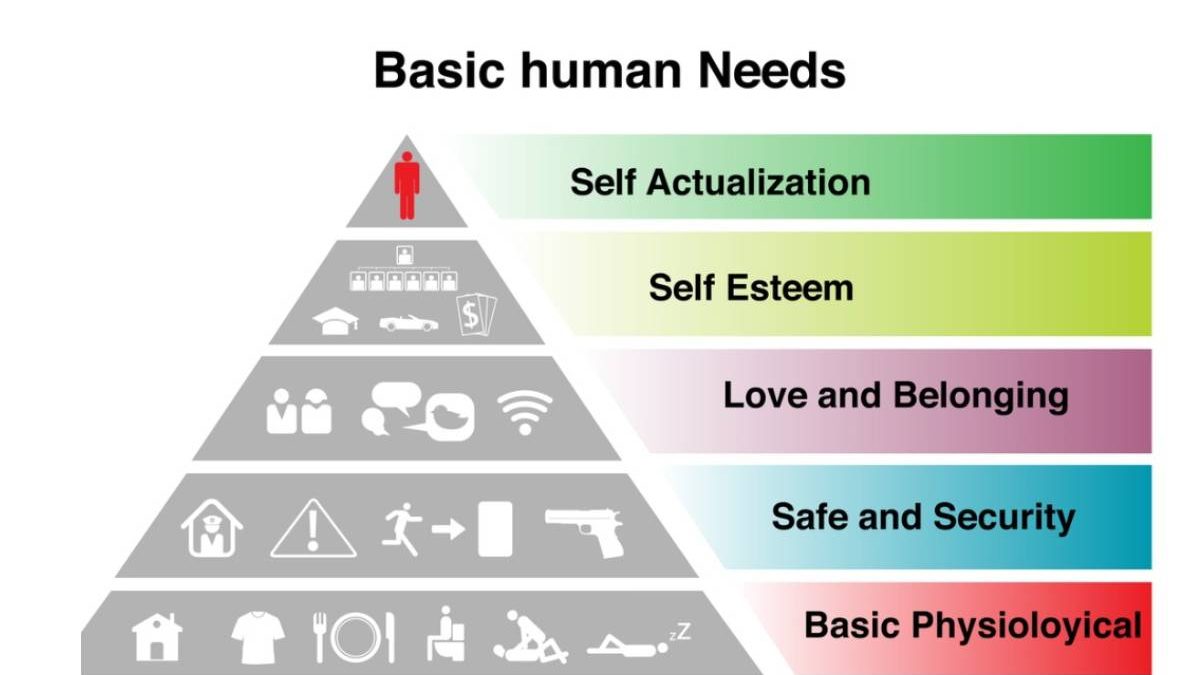Table of Contents
Introduction
Maslow’s Pyramid is a psychological theory that seeks to explain people’s behavior by defining each of the needs of the human being in a hierarchical order. It owes its name to the scientist Abraham Maslow, who proposed this Pyramid in his work “A Theory of Human Motivation,” published in English as “A Theory of Human Motivation” in 1943 and later expanded.
The theory visually explains people’s behavior and establishes five primary levels of needs that the human being has. These can be seen in a hierarchical order, starting from the base of the Pyramid and reaching the most advanced at the top of it. To the extent that basic needs are satisfied, those found at higher levels become more important.
Origin and Foundations
Maslow’s Pyramid was proposed in 1943 by American psychologist and psychiatrist Abraham Maslow in his work on human motivation. In this book, he argues that people’s actions are aimed at satisfying their needs, and once this is done, they will have the possibility to advance in their development. He used the Pyramid to visually represent the order of the five levels of need he established in his theory.
The Five Levels
The five levels of needs in the Pyramid have a hierarchical order of priorities that starts from the base or lower area, which represents the primary needs and rises progressively. Thus, according to the order established by Maslow, the levels of lack of the human being are distributed as follows:
Basic Or Physiological Needs
These are processes necessary to maintain the balance of the physiological system and health in general. It includes all the inherent needs of the human being required for the survival of an individual, such as breathing, hydration, food, clothing (or adequate shelter), sex, personal hygiene, rest, and pain avoidance. (related to diseases and conditions), etc.
Security and Protection Needs
Once basic needs are met, the person can begin to seek security and protection. It refers to the possibility of maintaining a state of order and security directly related to life expectations and conditions and its quality. It involves different aspects such as housing, physical security, the individual’s economic status, income, etc.
Social or Affiliation Needs

The social nature of the human being dominates people’s behavior in the third level. It seeks to belong to a group through different activities such as social or sporting events, family, relationships at work, friends, partners, etc. Relationships, participation, and social acceptance are essential to support the individual’s personal and professional values.
Esteem and Recognition Needs
Personal independence and meeting financial or other goals, trust, reputation, self-recognition, and others fall into this category. Maslow established an internal division at this level:
High esteem: it is the perception that an individual has about himself and has to do with self-respect, confidence, and security, among others.
Low esteem is about what others perceive of a person and how it affects him. In this sense, fame and reputation stand out, etc.
Strengthening these needs implies a vital contribution to a person’s self-esteem. The decrease in the satisfaction of these needs can make someone feel stuck. A strong concept of inferiority or undervaluation arises when none of them are fulfill.
Self-Actualization Needs
It is the feeling of personal success that can only be achieve by covering all the needs mention above. It is difficult to define the issues that make up this level since each individual can have their own goals. In addition, they are wishes that are generally fulfill through lengthy processes. A typical example of actions at this level is spiritual development and selfless help to others.
Examples for your Application

Maslow’s Pyramid may seem like a fundamental theory, but it still forms the foundation for an individual’s personal growth. Additionally, it raises relevant concepts for business, as it serves to devise the launch of new products or services. It is relevant because it allows evaluating the needs of people and looking for different ways to satisfy them. Here are some small examples:
Level 1
Many services seek to satisfy the basic needs of the public. Still, being an introductory level for life, there are different ways to innovate in the market and make life even easier for the consumer. An important example is the restaurants that satisfy the need for food and have innovated with delivery services. Real estate agents and clothing stores have also adopted an online format.
Level 2
With the digital age in full swing, precautions about security and protection also cover the virtual environment. The main threats are identity theft and hacking of personal or business accounts. In this sense, companies dedicated to cybersecurity will have an advantage, either in educational matters or with the sale of protection programs against malware.
Importance for Companies
Importance of the Maslow Pyramid for companies
The theory of motivation proposed by Abraham Maslow is a crucial tool for personal development since it can also be apply in the business world. The main areas in which the Maslow pyramid can be use are marketing and human resources.
Marketing
In the marketing area, Maslow’s Pyramid can be use to analyze people’s needs and try to satisfy them. It is crucial that the company can determine at what level its public is to offer a product that meets their needs. It will allow the consolidation of well-focused and objective marketing strategies based on the audience you want to reach.
Human Resources
Maslow’s Pyramid applies to the area of human resources to improve the general production of a company since meeting the needs of workers can contribute to improving performance in an organization. They can be motivate according to the level at which they are. It is crucial that in the selection process, the work conditions are report to know if it meets the candidate’s expectations.
Maslow’s Pyramid remains a theory in psychology that studies human motivation and behavior. If taken into consideration, it can mean necessary support for an individual’s personal development. It is also applicable in the business field to improve marketing strategies and general performance.
Conclusion
Maslow’s hierarchy of needs remains an idea in psychology proposed by American Abraham Maslow in his 1943 paper “A Concept of Human Motivation” in the journal Psychological Review. Maslow subsequently extended the idea to comprise his observations of humans’ innate curiosity.


